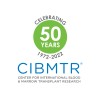
Human Placental-Derived Stem Cell Transplantation
Mucopolysaccharidosis IMucopolysaccharidosis VI14 moreThe purpose of this clinical trial is to investigate the safety of human placental-derived stem cells (HPDSC) given in conjunction with umbilical cord blood (UCB) stem cells in patients with various malignant or nonmalignant disorders who require a stem cell transplant. Patients will get either full dose (high-intensity) or lower dose (low intensity) chemo- and immunotherapy followed by a stem cell transplantation with UCB and HPDSC.

A Phase II Study Evaluating the Safety and Efficacy of Subcutaneous Plerixafor
Related Donors Donating Peripheral Blood Stem Cells (PBSC) to a Family MemberAcute Myelogenous Leukemia6 moreThis is a Phase II, open-label, two strata, multicenter, prospective study of plerixafor-mobilized HLA-identical sibling allografts in recipients with hematological malignancies. This study will establish the safety and efficacy of subcutaneous plerixafor for this purpose.

E7070, Idarubicin and Cytarabine in Relapsed AML and High-Risk Myelodysplastic Syndromes
LeukemiaThe goal of this clinical research study is to learn if E7070 in combination with idarubicin, cytarabine, and dexamethasone can help to control the disease in patients with either AML or high-risk MDS that has relapsed. The safety of the drug combination will also be studied.

Liposomal Cytarabine-Daunorubicin CPX-351 in Treating Patients With Untreated Myelodysplastic Syndrome...
Acute Biphenotypic LeukemiaAcute Myeloid Leukemia2 moreThis randomized clinical trial studies liposomal cytarabine-daunorubicin CPX-351 in treating patients with untreated myelodysplastic syndrome or acute myeloid leukemia. Drugs used in chemotherapy, such as liposomal cytarabine-daunorubicin CPX-351, work in different ways to stop the growth of cancer cells, either by killing the cells, by stopping them from dividing, or by stopping them from spreading.

Trial to Assess the Efficacy of a TCR Alfa Beta Depleted Graft in Pediatric Affected by ALL or AML...
Acute Lymphoblastic LeukemiaLeukemia Acute Myeloid - AML2 moreAllocation: Non-Randomized Endpoint Classification: Safety/Feasibility Intervention Model: Single Group Assignment Masking: Open Label Primary Purpose: Treatment Study to assess the feasibility and safety of the infusion of a T cells receptor (TCR) alfa beta depleted graft in pediatric patients affected by malignant and non-malignant hematological disorders and receiving an Hematopoietic stem cell transplantation (HSCT) from a Human leukocyte antigen (HLA) partially matched family donor.

Tosedostat in Combination With Cytarabine or Decitabine in Treating Patients With Newly Diagnosed...
Acute Myeloid Leukemia With Multilineage DysplasiaAdult Acute Myeloid Leukemia With 11q23 (MLL) Abnormalities7 moreThis study examines a new oral chemotherapy drug called tosedostat, in combination with cytarabine or decitabine. Tosedostat is thought to work by decreasing the availability of amino acids (building blocks the cell needs to make proteins) in cells. It has been shown in early studies to have activity against a variety of cancers, including leukemias. Patients with acute myeloid leukemia (AML) or high-risk myelodysplastic syndrome (MDS) with specific genetic mutations have a poorer response to chemotherapy and a higher risk of relapse after treatment. Researchers are looking to see if combinations of chemotherapy drugs may improve outcomes for patients that do not respond as well with the current chemotherapy regimens, without increasing the risks of treatment.

Study to Evaluate Pharmacokinetics, Food Effect, Safety and Efficacy of Oral Azacitidine
Myelodysplastic SyndromesLeukemia5 moreThe primary purpose of this study is to evaluate the pharmacokinetics of oral azacitidine when administered once daily as two 150-mg tablets, including the effect of food, and to evaluate the bioavailability of oral azacitidine 300-mg when administered as two 150-mg tablets relative to three 100-mg tablets.

Alvocidib, Cytarabine, and Mitoxantrone Hydrochloride or Cytarabine and Daunorubicin Hydrochloride...
Acute Myeloid Leukemia With Multilineage Dysplasia Following Myelodysplastic SyndromeAdult Acute Minimally Differentiated Myeloid Leukemia (M0)14 moreThis randomized phase II trial is studying how alvocidib, cytarabine, and mitoxantrone hydrochloride work compared to cytarabine and daunorubicin hydrochloride in treating patients with newly diagnosed acute myeloid leukemia. Alvocidib may stop the growth of cancer cells by blocking some of the enzymes needed for cell growth. Drugs used in chemotherapy, such as cytarabine, mitoxantrone hydrochloride, and daunorubicin hydrochloride work in different ways to stop the growth of cancer cells, either by killing the cells or by stopping them from dividing. It is not yet known whether giving alvocidib, cytarabine, and mitoxantrone hydrochloride is more effective than giving cytarabine and daunorubicin hydrochloride in treating patients with acute myeloid leukemia.

Vorinostat, Cytarabine, and Etoposide in Treating Patients With Relapsed and/or Refractory Acute...
Accelerated Phase Chronic Myelogenous LeukemiaAdult Acute Basophilic Leukemia34 moreThis phase I trial is studying the side effects and best dose of vorinostat when given together with cytarabine and etoposide in treating patients with relapsed or refractory acute leukemia or myelodysplastic syndromes or myeloproliferative disorders. Vorinostat may stop the growth of cancer cells by blocking some of the enzymes needed for cell growth. Drugs used in chemotherapy, such as cytarabine and etoposide, work in different ways to stop the growth of cancer cells, either by killing the cells or by stopping them from dividing. Giving vorinostat together with cytarabine and etoposide may kill more cancer cells.

Combination Chemotherapy in Treating Young Patients With Down Syndrome and Acute Myeloid Leukemia...
Childhood Acute Basophilic LeukemiaChildhood Acute Eosinophilic Leukemia13 moreThis phase III trial is studying how well combination chemotherapy works in treating young patients with Down syndrome and acute myeloid leukemia or myelodysplastic syndromes. Drugs used in chemotherapy work in different ways to stop the growth of cancer cells, either by killing the cells or by stopping them from dividing. Giving more than one drug (combination chemotherapy) may kill more cancer cells.
